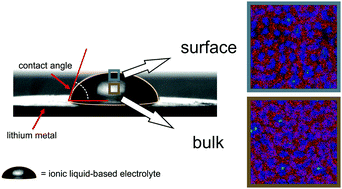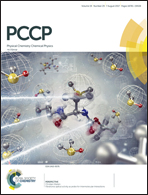Counterintuitive trends of the wetting behavior of ionic liquid-based electrolytes on modified lithium electrodes
Abstract
The demand for high energy densities has brought rechargeable lithium metal batteries back into the research focus. Ionic liquids (ILs) are considered as suitable electrolyte components for these systems. In this work, the wetting behavior of 1-ethyl-3-methylimidazolium bis((trifluoromethyl)sulfonyl)imide ([C2MIm]TFSI), 1-butyl-3-methylimidazolium bis-((trifluoromethyl)sulfonyl)imide ([C4MIm]TFSI), 1-hexyl-3-methylimidazolium bis((trifluoromethyl)sulfonyl)imide ([C6MIm]TFSI), and N-butyl-N-methylpyrrolidinium bis((trifluoromethyl)sulfonyl)imide (Pyr14TFSI) on mechanically modified lithium electrodes, with and without lithium bis((trifluoromethyl)sulfonyl)imide (LiTFSI) conducting salt, is investigated and is compared to an organic carbonate-based electrolyte. Three different patterns were chosen for the lithium modification, enabling a surface area increase of 12%, 20%, and 56% for the modified lithium electrodes. Especially for pure ILs, the contact angle on lithium was significantly larger with higher surface areas of the lithium electrodes. Since the addition of LiTFSI remarkably decreased the contact angles of the ILs on the modified lithium surfaces, it could be shown that the effect of LiTFSI can be attributed to a decreased surface tension. This observation could be explained by an interruption of the ordering of ionic liquid cations and anions, which is supported by Raman spectroscopy and molecular dynamics (MD) simulations.



 Please wait while we load your content...
Please wait while we load your content...